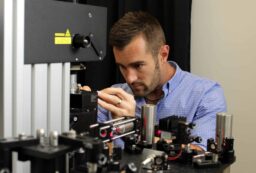Eye cells’ messaging system key to solving the problem of macular degeneration
Researchers from the Australian National University have found that maintaining communication between cells in the eye can prevent vision loss through age-related macular degeneration (AMD).
The incurable condition, resulting from damage to the macula region of the retina, causes loss of sight at the center of a persons field of vision.
While environmental and lifetsyle factors such as smoking and diet and genetics are risk factors in developing the condition, vision loss may be caused when cells in the eyes lose their ability to communicate with one another, causing the cells to become stressed and die.
“While humans generally use their voices or hands to communicate, cells use minute bubbles, called vesicles. These form on the outside of cells and move to others, transferring messages as a form of communication, like an email,” Dr Yvette Wooff, postdoctoral research fellow in the Clear Vision Research group at the Australian National University, says.
However, as we age we lose vesicles and, along with them, the messages they are meant to carry about cellular processes.
By understanding what the message within them is under normal healthy conditions and why this communication stops, Yvette hopes to slow the detoriation and ultimately develop a treatment for age related macular degeneration.
“My preclinical research began by understanding the language that retinal cells speak to each other, and uncovered part of the essential message communicated between them during health,” Yvette says.
“We have shown that if we supplement healthy retinal vesicles, or the molecular message contained within them, we can restore communication in the retina, and prevent vision loss,” she says.
Yvette and her team are working on a method to restore this communication by using vesicles from other healthy cells in the body as potential envelopes to carry the message as healthy retinal vesicles would.
She hopes that by using the patients’ own cells be a safer treatment option as there will be reduced immune reaction.
“We hope that within the next five years we can take these preclinical studies into clinical trials, and develop new therapies and delivery methods harnessing vesicle therapy to restore communication pathways and treat this currently untreatable disease.”
AMD currently affects one in seven people over the age of 65, and is predicted to affect 1.7 million Australians by 2030, and 288 million worldwide by 2040. It is estimated to cost the global economy around $350 billion a year.
Yvette’s work was funded by a 2021 BrightFocus Foundation Fellowship and a Macular Disease Foundation grant.





 Fresh Science is on hold for 2022. We will be back in 2023.
Fresh Science is on hold for 2022. We will be back in 2023.